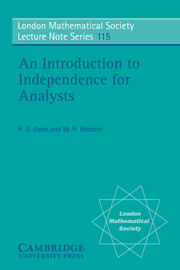1 - Homomorphisms from algebras of continuous functions
Published online by Cambridge University Press: 18 March 2010
Summary
Throughout this book, we shall work in the naïve set theory familiar to analysts: the formalization of this theory is the axiom system ZFC, which will be discussed in Chapter 4.
We first summarize some elementary facts about Banach algebras that we shall use. The account in the standard text of Rudin [58, Chapters 10 and 11] covers essentially all that we shall require.
All the algebras that we shall consider are linear and associative, and their underlying field is either the complex field C or the real field ℝ. An algebra is unital if it has an identity; in this case, we often denote the identity by e. The algebra formed by adjoining an identity to a non-unital algebra A is denoted by A#, and we take A# = A if A is unital.
The set of invertible elements of a unital algebra A is denoted by Inv A.
A character on a complex algebra A is a non-zero homomorphism from A onto ℂ. The set of characters on A is the character space of A, written ϕA.
Let A be a commutative algebra. An ideal I of A is modular if the quotient algebra A/I is unital. The (Jacobson) radical, written rad A, of A is defined to be the intersection of the maximal modular ideals of A; if A has no such ideals, then rad A = A, and in this case A is a radical algebra. (So our convention is that a radical algebra is necessarily commutative.) The algebra A is semisimple if rad A = {0}.
- Type
- Chapter
- Information
- An Introduction to Independence for Analysts , pp. 1 - 21Publisher: Cambridge University PressPrint publication year: 1987



